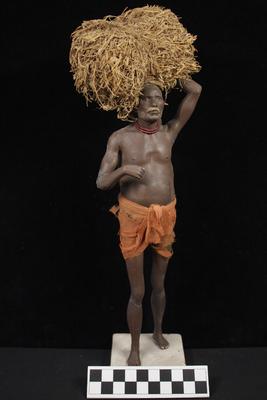E1250: India- Clay Figurine, Farm Laborer
Ethnographic
Identifier:
E1250
Classification Category:
8:Communication Artifacts ➞ Art/Folk Art
Marks/Labels:
N/A
Materials:
binding agents ➔ joiners ➔ metal wire ➔ armature
fabric ➔ cloth ➔ cotton
fabric ➔ thread ➔ embroidery thread
clay
botanical ➔ straw
Dimensions:
6.35 cm L
6.35 cm W
33.02 cm H
Provenance of Object:
This figure was probably manufactured in Krishnanagar, India. Krishnanagar figures are usually have very animated expressions and forms, and are considered to be so lifelike that they could have been modeled on actual people. This particular object exhibits these lifelike qualities, particularly in the realistic physique for a man of his age, as well as the clothing that he wears, which is reflective of the environment in which he worked.
Ethnic Group:
Asian ➞ India ➞ West Bengal ➞ Krishnanagar
Production Date:
c. 1860- 1870; given that George Winthrop was in India during the 1880s, it is highly likely that this figure was made before he actually came to India. Therefore, it could have been made as far back as 1860, 14 years before Winthrop arrived on the subcontinent.
Use/Function:
This figure was most likely used as a display and not for any use in particular. Krishnanagar figures are generally very delicate and are not meant to be played with; instead, they are meant to be decorative, and in some cases may symbolize class differences in the Indian caste system.
Source Locality:
This object is likely from Calcutta, India, or possibly Krishnanagar, which is a city in the vicinity of Calcutta.
Acquisition Date:
1874 – 1885
Description:
This figure is a typical example of a figure produced in Krishnanagar, a city located in West Bengal, India. It depicts a lowly farm laborer, who usually occupied the lower end of the caste system in Colonial India.

